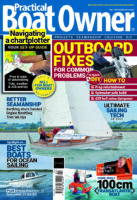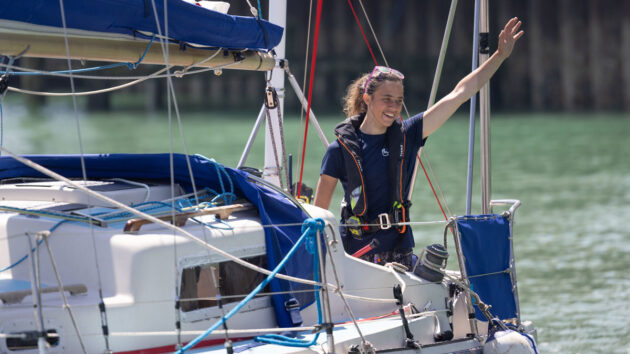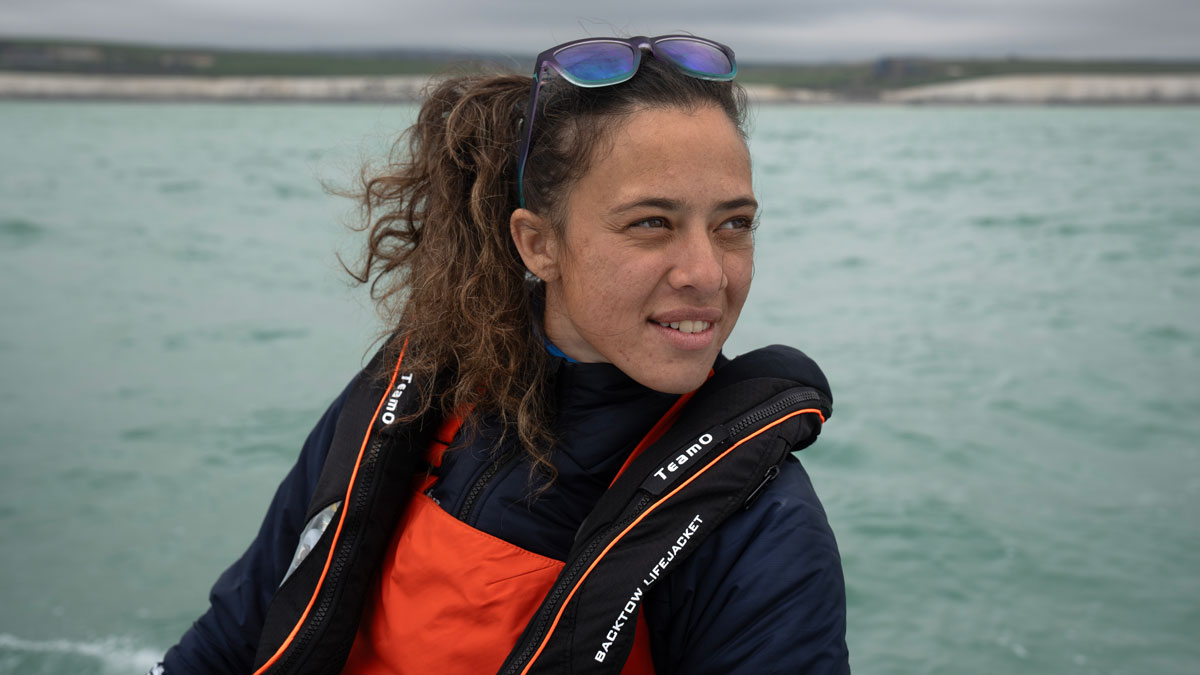Jazz Turner's extraordinary circumnavigation included support from Ben Ainslie and dolphins while battling chronic pain, navigating her Albin Vega 27 around the UK and Ireland through challenging weather and big waves.
When Jazz Turner turns 27 next Tuesday (8th July) the celebrations will be two-fold, coming just a week after she sailed into the history books as the first disabled person to complete a solo, non-stop, and unassisted circumnavigation of the UK and Ireland.
Turner may also be the first woman to sail solo, non-stop, and unassisted circumnavigation, without the use of an engine, of the UK and Ireland.
The 2,070-mile voyage, which is yet to be ratified by the Guinness World Records, saw hundreds of supporters turn out to greet Turner as she returned to Brighton Marina aboard her 1975 Albin Vega 27, Fear, which she rebuilt “from the ground up, total rewiring and everything else”.
After 28 days and 50 minutes at sea, Turner described four highlights:
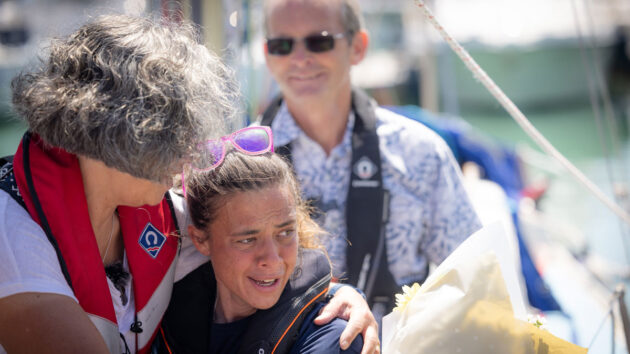
Jazz Turner hugs her foster mum Carolyn. Credit: Fergus Kennedy
- Firstly, being able to hug her foster parents, Chris and Carolyn Turner: “It felt like I couldn’t hold on tight enough to make up for all those moments when I wanted to hold them but couldn’t.
“Their support through all of this has been the constant that has kept me going.” - Secondly, being reunited with her adopted dog Phoebe: “The whole time I was away, it felt like I was missing a part of myself.
“Holding her and feeling her breath calmed me in a way nothing else could.” - Thirdly, a good swig of champagne. Turner said: “I was meant to attempt to spray it, but seeing as how my hands are a bit wonky, I gave up and just took a good swig.
“It was brilliant to drink something cold rather than lukewarm for a change!” - And last but not least, seeing four-time Paralympian and Para World Sailing manager Hannah Stodel, who said: ‘’I knew you could do it’, to which Turner replied: ‘I didn’t!’
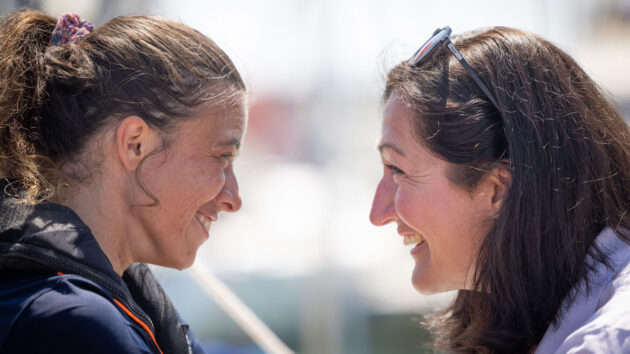
“I knew you could do it!” – Solo sailor Jazz Turner and four-time Paralympian Hannah Stodel share a poignant moment at the circumnavigation finish. Credit: Fergus Kennedy
Turner told PBO: “Hannah’s belief and support have been instrumental in getting me round and completing this challenge.
“Even though I planned to attempt a solo, non-stop, and unassisted circumnavigation of the UK and Ireland, I don’t think I ever really believed I could do it.
“Obviously it’s a big challenge to take on anyway, and with my health, it was a bit of a long shot as to whether it would work or not.
“So I don’t think I ever really let myself believe it was possible, because then I was only going to let myself feel really disappointed if it didn’t work out.”
What is Jazz Turner’s disability?
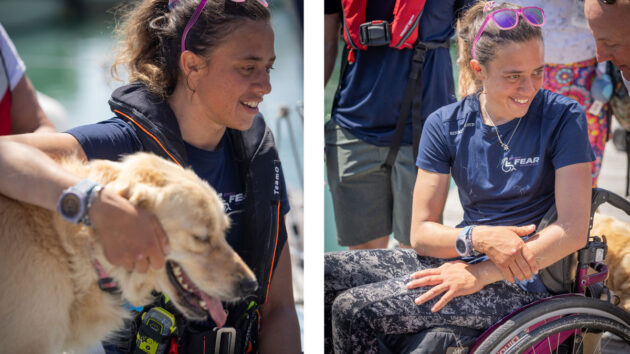
Jazz Turner with her beloved assistance dog Phoebe, age 7, who she adopted age one; and pictured in her wheelchair, at the voyage finish at Brighton Marina. Credit: Fergus Kennedy
Jazz Turner has a genetic, progressive condition called Ehlers-Danlos Syndrome, which affects connective tissue throughout the body and requires constant and careful medical management.
On land, Turner requires a wheelchair for much of the time, as it’s painful to bear weight on her legs and she is liable to fall over as her feet turn inwards and cannot balance. Every joint in her body is prone to dislocation.
Jazz Turner also has gastro-intestinal failure, which means that her digestive system struggles to process the food and drink she consumes.
Last December, she was given six months to live.
Turner’s foster dad Chris told PBO: “She has a postural orthostatic tachycardia syndrome (POTS) condition which means her heartrate goes through the roof, assistance dog Phoebe tells her to sit down before she passes out.
“When sailing she has a clever watch, which gives her a shorter warning of five minutes.”
He added: “Jazz currently has two tubes in body, she did have a third that fed directly to arteries in heart, that came out and they couldn’t fit it again, due to the risk to life.
“They told us in December 2024 that Jazz only had months to live, that was a low moment.
“They offered her a bed at the hospice but we didn’t want to risk sepsis, also she’s a 26 year old who wants to live life to the full, she might die quicker doing so but she would rather do that than be in a hospice with tubes, that’s a jail sentence.
“It seems that Jazz had a low point and is now coping without the third tube.
“The syndrome so little understood by medical profession, there’s so little research into it, that it’s a challenge to get clear concise understanding.”
Jazz Turner told PBO: “It is a terminal, progressive condition, so eventually my body will give up.
“There is no cure or treatment. It’s just a waiting game of how long it survives.
“I eat little amounts when I can. There are only certain specific foods that my body will tolerate.”
Her go-to food for the voyage was Pringles as these crisps have sturdier packaging for stowage than most, and Firepot dehydrated food mixed with boiling water, which Chris described as “a luxurious version of army rations.”
Possible final months
Rather than spending her final days in a hospice, Jazz Turner decided to “get out into the English Channel and turn right” aboard her boat Fear, which she and Chris have worked tirelessly on to get shipshape.
Whilst sailing clockwise around the UK and Ireland, she received messages of support from Sir Ben Ainslie, the most successful sailor in Olympic history, solo round-the-world yachtswoman Dame Ellen MacArthur, round-the-world yachtswoman Pip Hare, and Olympic medallist and America’s Cup veteran sailor Ian Walker from North Sails.
Turner said: “If you’re ever feeling a bit unsure, having that validation is just incredible.
“You can’t pay for the sort of years of experience they have.”
During the month at sea, Jazz Turner battled “really strong winds, a lot of upwind, and really big waves”, which was testing physically for her and the boat as “obviously falling off big waves is not ideal” as it creates a jarring effect for everything on board.
She also ran aground on the penultimate day.

Round-the-world yachtswoman Pip Hare was among the big names to send Jazz Turner messages of support. Credit: Jean-Louis Carli/ IMOCA
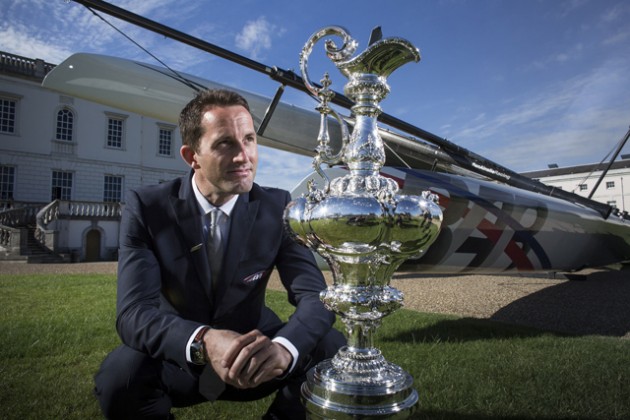
Sir Ben Ainslie helped to rally support for Jazz’s record-breaking voyage. Credit- Lloyd Images
Testing solo voyage
Turner said: “I ran aground off Folkstone, Kent about 24 hours before the finish.
“I put out two anchors so that when the tide came in, I could pull myself off into deeper water using the anchors, and then I anchored again out in the bay once I was free to just check everything was alright and wait for the wind before continuing on.”
That solution sounds straightforward but actually involved Turner ‘crawling 50m across the rocks’ with an anchor on her back – twice – for the bow anchor and then the kedge anchor, although that line only required a 40m rock crawl.
The endeavour provided a thorough test of her technical clothing.
Turner said: “Henri Lloyd was my technical clothing partner and provided all my kit, which was invaluable, because offshore kits are really expensive. And obviously you give it a pretty brutal bashing when you do something like this.
“It was really good and even held up to me crawling across the rocks with an anchor on my back. It didn’t even rip when I did that.”
Other challenges included “lots and lots of breakages”.
Turner said: ‘The first week, the wind didn’t drop below 25 knots, with a south westerly beating all the way down to Cornwall.
“So that was pretty brutal physically, both for me and the boat.
“All the windows started leaking, the chartplotter and compass broke.
“There were quite a few challenges initially.
“After that, it sort of calmed down but it was tough conditions the whole way around basically.”
Fixes at sea
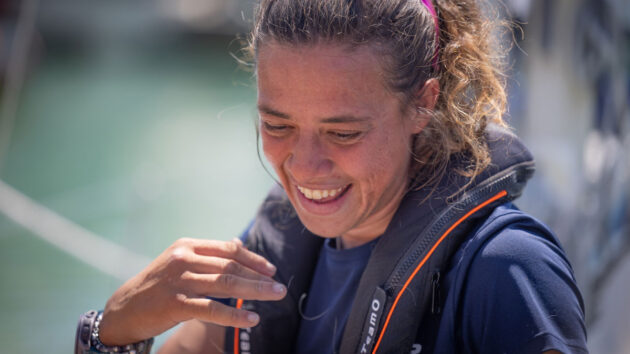
During the month at sea, Jazz Turner battled “really strong winds, a lot of upwind, and really big waves” which was testing physically for her and the boat. Credit: Fergus Kennedy
One fix involved Turner going upwind in 20 knots with a silicon sealant gunk gun, trying to reseal the windows.
She said: “It did actually work but then it gave up about three weeks later and I had to redo them.
“And then there were lots of little things like reducing chafe, so putting more pulleys and things into the reefing lines to try and reduce wear on the ropes.
“We’d done lots of really brutal test sails, but nothing compared to the real thing, it turned out.”
Turner’s essential kit for the voyage was a chart plotter, an automatic identification system (AIS) and radar.
She said: “Raymarine provided me with a full set of kit. The chart plotter, the AIS, and the radar were all invaluable in setting the alarms off, to wake me up if I was going to hit anything. I literally couldn’t have done it without my chart plotter.
“But I did break the chart plotter. I dropped the winch handle on it on day one, about two hours in, and it cracked the screen.
“So although it did work, it was a little bit dodgy, I couldn’t get it wet, for example. But it had buttons on the side, which meant I could still get it to work.
“But after I cracked it, the screen wasn’t brilliant to see and it had its moments where it randomly would think I’m in Russia or Australia for some reason.”
Managing her condition was another hurdle.
Turner said: “It definitely makes it more complicated when you can’t really support yourself, and when you’re struggling to eat or drink enough to get enough energy into yourself.
“And then dealing with the fact that you know you’re constantly dislocating all your joints, so that means you’re in a lot of pain. My hands got really swollen and painful.”
Even so, Turner has surprised herself by wanting to get back out on the water already.
She said: “I didn’t expect to want to go back out quite so soon.
“But the boat’s got to be out the water for a little bit now, to get some checks and repairs done after the bashing it’s been given over the last month.”
Inspirational moments
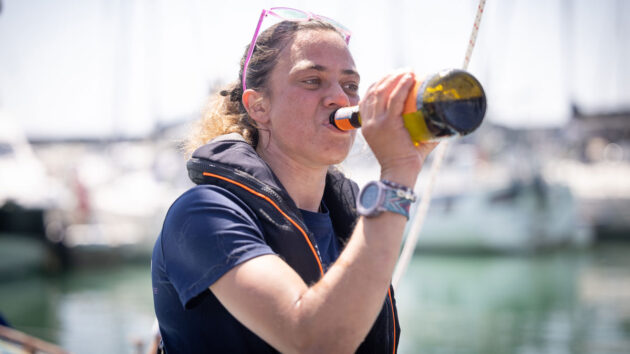
Jazz said a swig of champagne was wonderfully cold and refreshing after all the warm water she’d drunk during the voyage. Credit: Fergus Kennedy
Highlights for Turner included rounding Muckle Flugga Lighthouse at the northernmost point of the Shetland Islands – which marked a circumnavigational milestone.
She said: “I didn’t actually expect to make it that far. So getting there was a massive boost, an incredible achievement.
“But I also had other really special moments where, actually, I was pretty much in tears, screaming at the boat and screaming at the wind, and then I got joined by some dolphins, and they swam alongside for a bit, and I just kind of told them everything
“I felt like they were willing me to carry on.”
The endeavour was nonstop, so from 2-30 June, Turner’s method for getting sleep safely while sailing was to nap for “20 minutes to an hour at a time, check you’re not about to hit anything and then carry on”.
She said: “It’s easier when you’re offshore, because, obviously it’s a lot less stressful.
“But coming down the East Coast was pretty gruelling, purely because you’re constantly avoiding oil rigs, tankers and wind farms, so there’s very little time to rest. That was difficult.”
Early years

Solo sailor Jazz Turner, first disabled person to complete a non-stop, unassisted circumnavigation of the UK and Ireland, was shocked by the huge turnout to welcome her back to Brighton Marina. Credit: Fergus Kennedy
Turner learned to sail from age 13, after joining her local sailing club.
She said: “I basically crewed for people and annoyed people until they gave me opportunities and learned to sail that way.”
Having grown up in an abusive household, sailing at Newhaven and Seaford Sailing Club (NSSC) provided Turner with an escape – and a new family – as she met her foster-dad-to-be Chris, a retired engineer and keen Fireball dinghy sailor, and his wife Carolyn, a general practitioner, who gave her a home from the age of 18.
They supported her through her A-levels at Bede’s Senior School in Sussex and her degree in mechanical engineering at Sussex University.
Turner told PBO: “I’m legally emancipated from my biological parents. I have no contact with them.
“It was both physical and emotional abuse. As a child I was moved around a lot between various different relatives, as well as locations, both nationally and internationally.
“My childhood was a combination of being home schooled as well as various international schools, because I didn’t live in the UK as a kid.
“I’d never been to doctors until I was 17, so there was no one to pick up on the fact that I had a progressive condition.
“I assumed the pain I lived with was normal.
“There is no treatment for my condition, but having the support of my foster family, living in one place and being able to put in preventative measures obviously helped.”
Turner said Chris and Carolyn “weren’t hugely thrilled by the idea” of her setting off around Britain solo in her yacht, but added: “I’m very lucky in that they’ve always backed me, no matter what. I think they knew I would do it whether they helped or not. So they got on board.”
Knowing that the Royal National Lifeboat Institution (RNLI) volunteer lifeboat crews around the UK and Ireland are ready to answer their pagers 24/7, 365 days a year to help anyone in difficulty at sea, was a big comfort to Turner’s family.
She added: “Obviously the safety aspect was always really important.
“I was never going to put myself or the boat at risk, or at least try not to, even if it meant giving up on the non-stop aspect of the challenge.
“I love sailing solo. When I race the dinghies, I race double handed, but I do love the independence and freedom of it just being me in the boat.
“Ever since being little, I’ve always been obsessed with the water, but sailing was when it really clicked for me.”
Sailing pathway
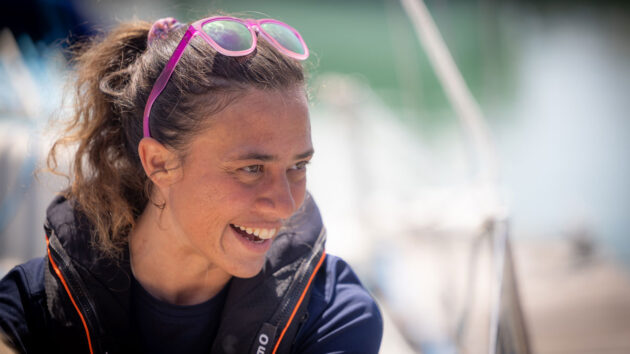
After 28 days and 50 minutes at sea, solo sailor Jazz Turner smiles at a rapturous welcome at Brighton Marina. Credit: Fergus Kennedy
After getting afloat on dinghies – Toppers, Lasers, Fireballs, then 420s – Turner, who was mostly self-taught, transitioned into the Para classes of the 2.4 and the RS Venture Connect.
Three years ago, Turner started doing more keelboat sailing.
She said: “I did lots of crewing for boats down in the Solent, working as a navigator and tactician. And then officially, last year, I took the jump and bought my own boat.”
Summing up boat ownership, Turner said it’s “expensive!”
She added: “I mean, it’s a rollercoaster, but there’s nothing quite like it. I think you always have a connection with your boat, but me and Fear have a very special connection.
“She’s a very old 1975 boat so we basically had to totally rebuild her from the ground up, total rewiring and everything else.”
The freedom sailing offers, outweighs the maintenance and cost, Turner said: “I can go where I want, when I want the boat, usually much to everyone’s annoyance, whereas, you know, on land, I’m pretty much reliant on my wheelchair or somebody to help me around.
“So it’s I just get independence, I don’t get anywhere else.”
Jazz Turner was overwhelmed by the turnout for her voyage finale in Brighton Marina, where Fear is berthed.
She said: “I guess I expected some of the yacht club boats to come out, but I was shocked to see 25 to 30 boats waiting to escort me in, and then when I came into the marina, people were lining the harbour arm and the walkways, cheering and waving.
“Most of them I had never met but they had got involved in the journey and wanted to see me come in safely.
“It was incredibly humbling to see just how far Project Fear had gone.”
On-the-water supporters included members of Brighton Marina Yacht Club, as well as the safety boats and committee boat from NSSC.
Paying it forward
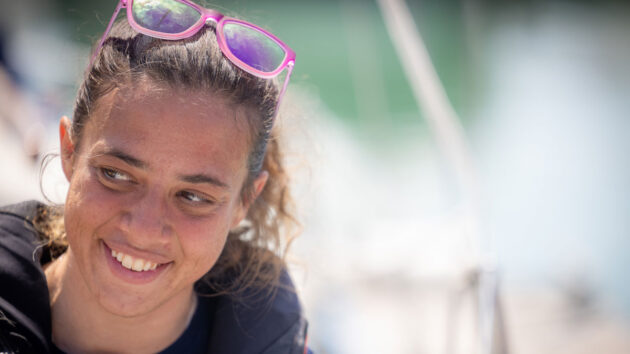
Jazz’s voyage has raised more than £50,000 for Newhaven and Seaford Sailability. Credit: Fergus Kennedy
Turner’s fundraising efforts will now enable even more people to experience the joy of sailing, as she has raised more than £50,000 for Newhaven and Seaford Sailability, which is run at her club.
She said: “We’re literally in the process now of buying two more adapted Hansa dinghies, a trailer to allow people to go to events, servo systems so that some of our participants with more complex disabilities can use motors to help them steer.
“And then we’ll work out what the rest of the money goes towards.”
She added: “I’ve had messages from parents of disabled children saying how their kids have been following all along, and they’ve been inspired to get out on the water.
“I’ve also had quite a lot of messages from people who also suffer with seizures, saying that, having seen what I’ve done, they’re inspired to contact their local Sailability centre and see if they can support them to get them on the water. So that’s been really good.
“I can’t wait to get back out on the water and see what challenge I can take on next.”
Follow @jazturnersailing on Facebook and support the cause at www.gofundme.com/f/project-fear
Jazz Turner’s Project Fear is sailing at its “most compelling”
Jazz Turner's Project Fear solo, non-stop and unassisted round-Britain circumnavigation attempt is sailing at its "most compelling."
Jazz Turner becomes first wheelchair user to circumnavigate Britain solo
At around 13:45 on Monday, 30th June, Jazz Turner, a GB para-athlete and engineer from Seaford, East Sussex, has become…
Sailing with limited mobility: a practical guide
Deteriorating mobility has forced Kerry Buchanan to modify habits aboard – but she’s still sailing!
How to sail around the UK and Ireland
Sam Steele explains everything you need to know about a circumnavigation of Britain and Ireland
Want to read more articles like this?

A subscription to Practical Boat Owner magazine costs around 40% less than the cover price.
Print and digital editions are available through Magazines Direct – where you can also find the latest deals.
PBO is packed with information to help you get the most from boat ownership – whether sail or power.
-
-
-
- Take your DIY skills to the next level with trusted advice on boat maintenance and repairs
- Impartial, in-depth gear reviews
- Practical cruising tips for making the most of your time afloat
-
-
Follow us on Facebook, Instagram, TikTok and Twitter

